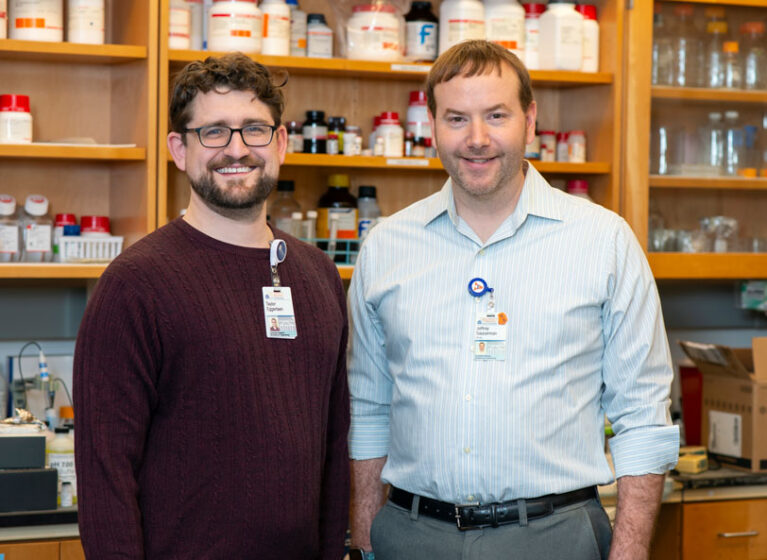
A recent discovery at UVA Health shows promise for uncovering new heart failure treatments. Biomedical engineer Jeffrey Saucerman, PhD, and biomedical engineering graduate student Taylor Eggertsen created a drug-screening tool that helped them identify a chemotherapy drug with the capacity to treat and prevent heart failure. In computer simulations, midostaurin — a drug commonly used to treat acute myeloid leukemia — slowed down cardiac hypertrophy, a cause of heart failure.
Developing new treatments is more critical than ever, with heart failure rates rising and the mortality rate at 50% within 5 years of diagnosis. "This new computer tool helps us find new uses for old drugs, and it also explains how they may work in the heart," Saucerman says. "New drugs take decades to develop. We hope this tool will help us find drugs for heart failure that are already known to be safe and effective for other diseases."
Using Simulations to Predict Cell Behavior
Saucerman and Eggertsen designed the drug screening tool to help them understand how certain drugs already approved by the Food and Drug Administration (FDA) would affect the behavior of cardiomyocytes, the cells responsible for contractions in the heart.
Using the tool, they modeled the harmful growth of cardiomyocytes before heart failure. Then, they ran simulations demonstrating how existing drugs would impact that process.
The researchers screened more than 250 drugs that showed initial promise for heart disease. Of those, 38 that slowed cardiac hypertrophy. When they tested the most promising drugs in the cardiomyocytes of neonatal rats, they found that midostaurin inhibited cardiomyocyte hypertrophy.
Midostaurin is currently indicated for the treatment of bone marrow cancer.
Taking Advantage of Protein Circuits
“The protein circuitry by which cells make decisions is very similar from cell type to cell type,” Saucerman says. “It’s using the same decision-making process and controlling different cell functions in different cell types. That’s why midostaurin, which is useful in a leukemia setting, also targets the same protein in a cardiomyocyte. And that means this unexpected role for midostaurin could be true for other cell types with the same protein, too.”
The researchers concluded that midostaurin should be considered as an antihypertrophic drug. But they also note that the tool could create simulations for any number of cell-signaling networks. “I think there are a lot of drugs that can be repurposed and have potential in areas outside of what they were designed to treat,” Eggertsen says.
Next Steps for Midostaurin and Heart Failure
Now that they’ve validated the model’s predictions for midostaurin through cell-based experiments, Eggertsen and Saucerman say the next step is animal studies and then, hopefully, clinical trials.
“I think it would be really interesting to talk to clinicians and get an idea of how a clinical trial would be designed,” Eggertsen says.
Saucerman adds: “At the clinical trial stage, we’d be able to work with the FDA to identify a much more focused late-stage trial that is less costly and less time-intensive than developing a new drug, because the safety of the drug has already been established.”
The UVA Health researchers are also completing a retrospective analysis of clinical data to see whether their findings line up with patient data.
Identifying Both Positive and Negative Impacts
Saucerman and Eggertsen hope other researchers can use their drug screening tool to help illuminate why some drugs disrupt cell behaviors in certain situations.
“It’s certainly great to find drugs that show a beneficial effect in an area other than what it was originally designed to do. But there’s also the other side of it, where it allows us to gain insight into the negative impact drugs can have on areas they weren’t originally designed to affect,” Eggertsen says.
For example, while Saucerman and Eggertsen were able to identify 1 cancer drug that could be beneficial in the heart, their simulations also found 7 other cancer drugs that showed possible cardiotoxicity.
“These relationships can go in either direction,” Saucerman says. “The simulations help us identify the possibilities earlier in the process.”
Saucerman and Eggertsen are also exploring other ways of using their tool to evaluate problems with medications. “We’re now starting to look at the clinical data first about adverse reporting by the FDA to identify cases where drugs are causing problems, and then using that to prioritize our basic science studies and figure out why those problems might exist,” Saucerman says.
Saucerman and Eggertsen published their research, funded by the National Institutes of Health, in the British Journal of Pharmacology.